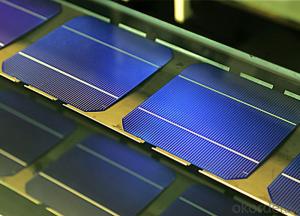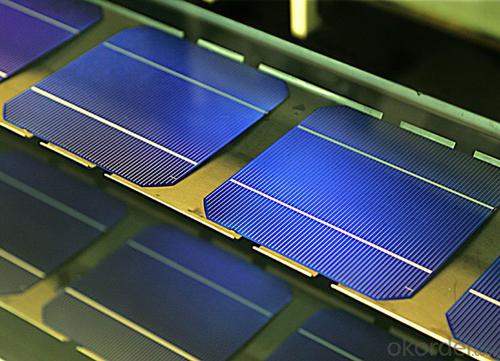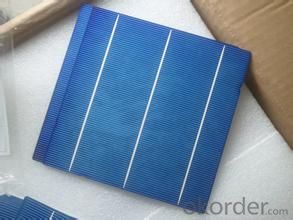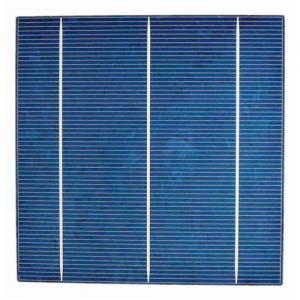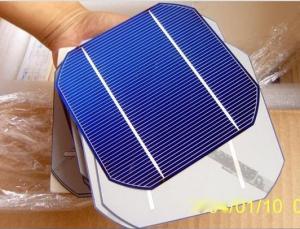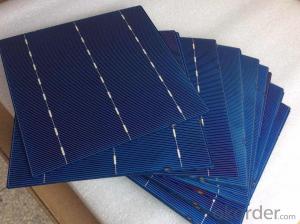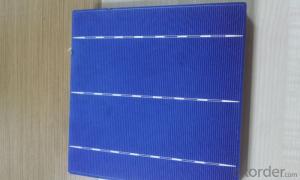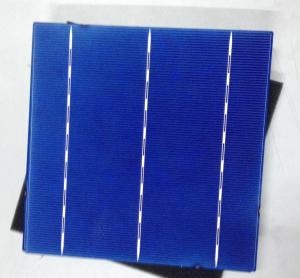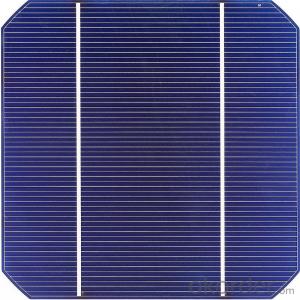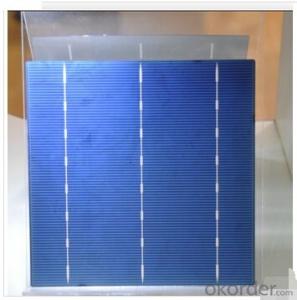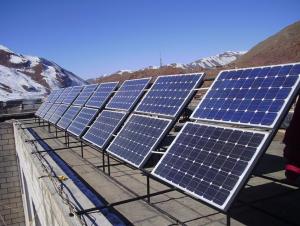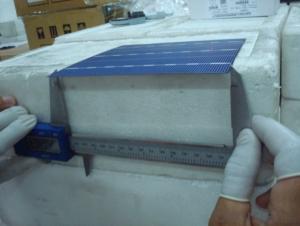Graphene Based Polycrystalline Solar Cells - Tire 1 Manufacturer in China - 17.00%
- Loading Port:
- Shanghai
- Payment Terms:
- TT OR LC
- Min Order Qty:
- 10000 watt
- Supply Capability:
- 500000 watt/month
OKorder Service Pledge
OKorder Financial Service
You Might Also Like
Brief Introduction of Solar Cells
A solar cell, is an electrical device that converts the energy of light directly into electricity by the photovoltaic effect, which is a physical and chemical phenomenon. It is a form of photoelectric cell, defined as a device whose electrical characteristics, such as current, voltage, or resistance, vary when exposed to light. Solar cells are the building blocks of photovoltaic modules, otherwise known as solar panels.
Specifications of Polycrystalline Solar Cells
Format : 156 mm × 156 mm ± 0.5 mm
Thickness: 210 μm ±40 μm
Front (-) : 1.5mm bus bars (silver),blue anti-reflection coating (silicon nitride)
Back (+) : 2.5mm wide soldering pads (silver) back surface field (aluminium)
Efficiency (%) | Pmpp (W) | Umpp (V) | Impp (A) | Voc (V) | Isc (A) |
18.00% | 4.38 | 0.528 | 8.291 | 0.631 | 8.869 |
17.80% | 4.33 | 0.525 | 8.252 | 0.629 | 8.821 |
17.60% | 4.29 | 0.532 | 8.053 | 0.633 | 8.541 |
17.40% | 4.23 | 0.528 | 8.092 | 0.624 | 8.632 |
17.20% | 4.19 | 0.524 | 7.992 | 0.62 | 8.458 |
17.00% | 4.14 | 0.52 | 7.972 | 0.623 | 8.5 |
Advantage of Polycrystalline Solar Cells
1. Tire-1 Solar Cells’ Manufacturer Quality Guarantee. With a complete and sophisticated quality government system, our Quality Management have arrived world’s leading place. Customer can receive Tire-1 Cells Maker’s Quality Standard Products.
2. Trusted Warranty. We can supply trusted after-sales service to our customer. If our cells are found not in conformity to the specification of manufacturer, or should the inspected quantity found in shortage, or should the packing found damaged, the buyer has the right to claim to the seller. The claim, if any, should be presented to seller within 30 days after cargo's arrival date to the port, together with related inspection report and photos issued and provided by a reputable independent surveyor such as SGS.
3. World’s Leading Manufacturer Equipment. We imported the newest and leading production equipment from abroad. Advanced equipment can guarantee the stable quality of cells. Auto production line can also save labor cost which will further cut our production cost.
4. Bulk supply: With the production capacity of 500MW, we can produce large quantity every month. This can satisfy most customer requirement.
Usage of Polycrystalline Solar Cells
Solar cells are often electrically connected and encapsulated as a module. Photovoltaic modules often have a sheet of glass on the front (sun up) side, allowing light to pass while protecting the semiconductor wafers from abrasion and impact due to wind-driven debris, rain, hail, etc. Solar cells are also usually connected in series in modules, creating an additive voltage. Connecting cells in parallel will yield a higher current; our solar cells have passed IEC Certification. With high and stable quality, our cells can greatly improve the performance of Solar Modules.
Applications of Polycrystalline Solar Cells
Assemblies of photovoltaic cells are used to make solar modules which generate electrical power from sunlight, as distinguished from a "solar module" or "solar panel". A solar array generates solar power using solar energy.
Packaging & Delivery of Polycrystalline Solar Cells
Carton Box Package and Deliver by air. It should be noticed that it should be avoid of water, sunshine and moist.
Factory Picture of Solar Cells
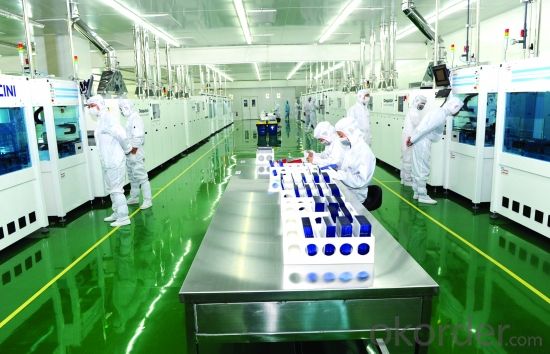
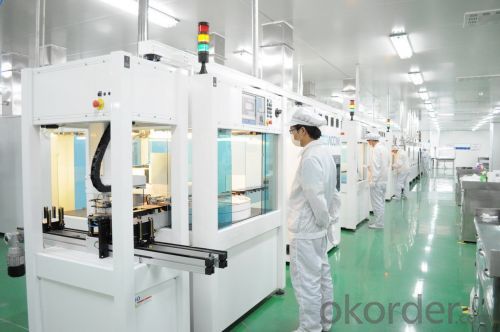
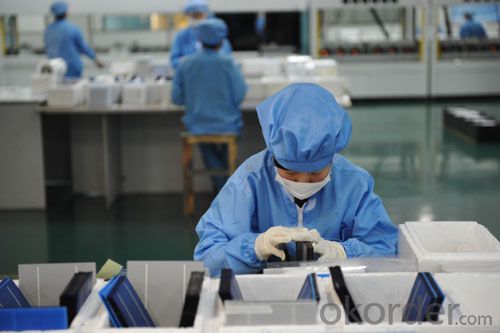
We have organized several common questions for our clients,may help you sincerely:
1. What’s price per watt?
A: It’s depends on the quantity, delivery date and payment terms of the order. We can talk further about the detail price issue. Our products is high quality with lower price level.
2. Can you tell me the parameter of your solar cells?
We have different series of cells with different power output, both from c-si to a-si. Please take our specification sheet for your reference.
3. How do you pack your products?
We have rich experience on how to pack the panels to make sure the safety on shipment when it arrives at the destination.
4. Can you do OEM for us?
Yes, we can.
5. How long can we receive the product after purchase?
In the purchase of product within three working days, We will arrange the factory delivery as soon as possible. The perfect time of receiving is related to the state and position of customers. Commonly 7 to 10 working days can be served.
- Q: How do solar cells handle voltage fluctuations in the grid?
- Solar cells do not directly handle voltage fluctuations in the grid. However, they can contribute to stabilizing the grid by generating electricity from sunlight, which helps balance the supply-demand equation. To manage voltage fluctuations, grid operators use various methods such as energy storage systems, inverters, and smart grid technologies that can regulate and control the flow of electricity in the grid.
- Q: Can solar cells be used for space applications?
- Yes, solar cells can be used for space applications. They are commonly used in space missions to generate electricity from sunlight. Solar cells are lightweight, durable, and efficient in converting sunlight into electrical energy, making them an ideal choice for powering spacecraft and satellites in the harsh environment of space.
- Q: How do solar cells perform in areas with limited space for installation?
- Solar cells can still perform efficiently in areas with limited space for installation through the use of innovative technologies such as rooftop and building-integrated photovoltaics. These systems maximize the use of available space, allowing solar cells to generate electricity even in compact urban environments. Additionally, advancements in solar cell design and efficiency have made it possible to produce more power from smaller areas, further optimizing electricity generation in limited spaces.
- Q: Can solar cells be used for off-grid applications?
- Yes, solar cells can be used for off-grid applications. Solar cells, also known as photovoltaic (PV) cells, convert sunlight into electricity. This renewable energy source can be harnessed to power various off-grid applications such as remote homes, cabins, or even portable devices. By installing solar panels and storage batteries, off-grid systems can generate and store electricity for use when there is no access to a traditional power grid.
- Q: How do solar cells perform in areas with high levels of noise pollution?
- Solar cells are not affected by noise pollution as it has no impact on their performance. Noise pollution does not interfere with the ability of solar cells to convert sunlight into electricity, making them a reliable energy source even in areas with high levels of noise pollution.
- Q: Can solar cells be used for outdoor signage?
- Yes, solar cells can be used for outdoor signage. They are an environmentally friendly and sustainable option that can provide power to illuminate and operate outdoor signs. Solar cells can capture sunlight and convert it into electricity, making them an ideal choice for outdoor signage that is located in areas with ample sunshine.
- Q: How do solar cells perform in areas with high levels of chemical pollutants?
- Solar cells can be negatively affected by high levels of chemical pollutants in the air. The presence of pollutants can reduce the efficiency of solar cells by blocking sunlight and creating a layer of dirt or grime on the surface of the cells. This can lead to a decrease in electricity generation and overall performance of the solar cells. Regular cleaning and maintenance can help mitigate the impact of chemical pollutants on solar cell performance.
- Q: What's the relationship between solar energy materials and solar cells?
- Solar cells are made by the solar energy materials, which are actually basically silicon, a very developed and commonly used materials in the solar energy industry.
- Q: Can solar cells be used in disaster recovery efforts?
- Yes, solar cells can be used in disaster recovery efforts. Solar cells can provide a reliable and sustainable source of electricity in areas affected by disasters, where traditional power grids may be damaged or inaccessible. They can be used to power emergency shelters, hospitals, communication systems, and other critical infrastructure, ensuring that essential services and relief efforts are not disrupted. Additionally, solar cells can be easily deployed and are not dependent on fuel supply, making them an ideal solution for disaster recovery efforts.
- Q: How does a solar cell raise industrial efficiency?
- A solar cell provides long-lasting electricity which is vital in factories, that's how it raises efficiency.
Send your message to us
Graphene Based Polycrystalline Solar Cells - Tire 1 Manufacturer in China - 17.00%
- Loading Port:
- Shanghai
- Payment Terms:
- TT OR LC
- Min Order Qty:
- 10000 watt
- Supply Capability:
- 500000 watt/month
OKorder Service Pledge
OKorder Financial Service
Similar products
Hot products
Hot Searches
Related keywords
